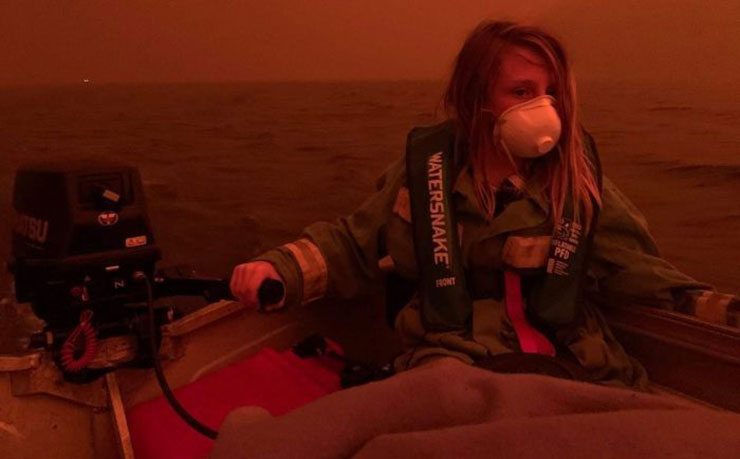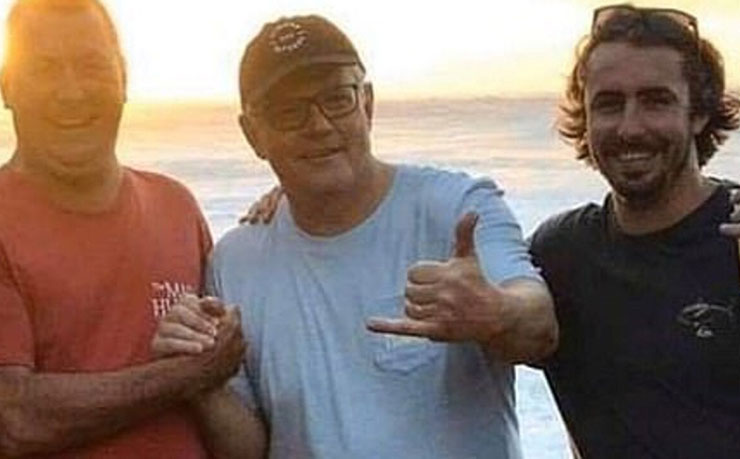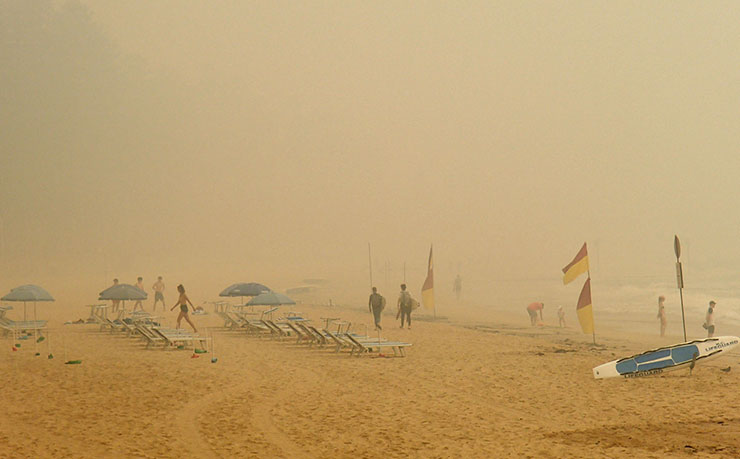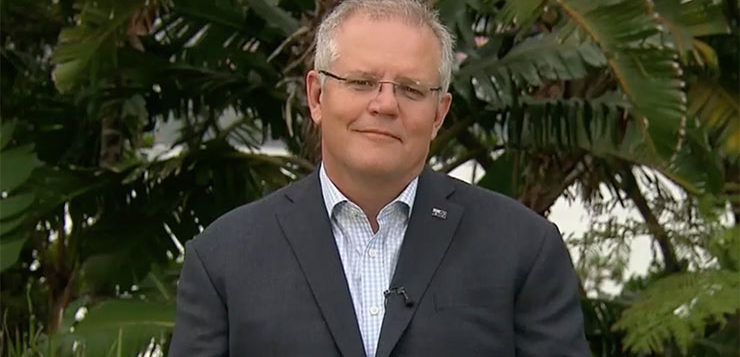DON’T MISS ANYTHING! ONE CLICK TO GET NEW MATILDA DELIVERED DIRECT TO YOUR INBOX, FREE!
Scott Morrison can’t handle the bushfires, because he can’t handle climate change itself, writes Ben Eltham. Australia’s leader is failing our nation.
Large parts of Australia burned on New Year’s Eve. They burned the day before that, and the week before that, and the month before that too.
Driven by high temperatures and fierce winds, infernal fires swept through southern New South Wales and eastern Victoria. Lives were lost, animals killed, homes and properties destroyed. Whole towns in Gippsland and the South Coast were razed to the ground by the conflagrations.
As so often happens in natural disasters, it was photography rather than written reporting that conveyed the full magnitude of the situation. In particular, a remarkable photo of 11-year old Mallacoota boy Finn Burns crystallised the existential horror of Australia’s climate crisis.

Wearing a dust mask and a life jacket, the 11-year old boy calmly piloted a dinghy holding his mother and brother across the water, under a blood red sky. The family were escaping the onrushing fire front that engulfed the town on New Years Eve.
Other photographs told of other horrors: holiday makers huddling together on the Mallacoota beach and pier, cars parked in the waters of Lake Conjola, raging firestorms engulfing fire trucks, burnt out main streets of country towns like Mogo, Cobargo and Sarsfield. At least 15 people have died and thousands of homes and businesses have been destroyed.
Australia’s forests and croplands have been burning since July. The scale of the fires is so large, it is difficult to comprehend. The fires dwarf recent destruction in California, Brazil or Siberia. So intense are the blazes, New Zealand has been blanketed in thick smoke. This is an event of global significance.
Through it all yesterday, Prime Minister Scott Morrison was at his official residence at Kirribilli House in Sydney, apparently unconcerned.
As southern Australian burned, Scott Morrison threw a New Year’s Eve function with his family and friends to watch the fireworks from Kirribilli House. On New Year’s Day, as the first devastating reports filtered in of the destruction on the south-east coast, Morrison appeared at a charity cricket function for Cricket Australia and the McGrath Foundation.
Morrison’s only concession to the unfolding crisis was a bizarrely upbeat video message on New Year’s morning. Posing with his wife Jenny, as he has done often recently, Morrison told Australia that “there’s no better place to raise kids anywhere on the planet, and we’re all so grateful that we can live in this amazing country, and that’s something we can always give thanks for as we enter into their new year”.
The Prime Minister’s weird New Year’s Day address continues his strange behavior this summer, which has combined policy apathy with a stubborn refusal to acknowledge that there is anything much to worry about.
Morrison’s otherworldly unconcern for one of Australia’s worst natural disasters in decades has puzzled some, and angered many more. Why has the Prime Minister found it so difficult to put aside his holiday activities and concentrate federal energy and attention on the unfolding catastrophe? Why did Morrison go to Hawaii on a family holiday, and then instruct his spin doctors to lie about the trip to the media?

Why did it take more than a week of political pressure for Morrison to authorise cash payments to New South Wales volunteer firefighters, and then further days to authorise payments to Queensland firefighters? Why did it take until a desperate phone call from Victorian premier Dan Andrews on New Year’s Eve for Morrison to call out the Australian Defence Force?
The answer, I think, is in two parts.
First, Morrison has gone to pieces under pressure. This is not a new development: we’ve had ample evidence, across six years of his record in office, that the Prime Minister genuinely struggles under the pressure of events or criticism.
Morrison has a glass jaw. He hates negative publicity and tends to react to it by attacking his critics, often making wild and unsubstantiated claims in the process. Time and again as Immigration Minister and then as Prime Minster, Morrison has responded to pressure by flying off the handle. We saw it in his misleading response to the murder of Reza Berati, in his false allegations levelled against Save the Children, and more recently with his meltdown at the Pacific Forum in Tuvalu. Morrison has also regularly thrown out false or misleading information in an effort to redirect media attention and avoid scrutiny for his performance in office.
Secondly, and perhaps more importantly, Morrison can’t bring himself to acknowledge the severity of the current crisis, because to do so would be to acknowledge that catastrophic climate change has arrived in Australia.
As Lenore Taylor wrote in the Guardian yesterday, Morrison is heavily invested in trying to pretend that this is not a big deal, simply another regrettable episode of Australia’s long history of bushfires.
If [Morrison] acknowledges the fact that it is abnormal he would need to concede that global heating is part of the cause of this unprecedented situation, and that would increase pressure for Australia to do something about it, by developing a credible climate policy, instead of just pretending that we have one. So, despite the evidence all around us, the prime minister keeps recycling the spin.
Taylor is on to something here.
Morrison’s sluggish response to the bushfires is in line with the broader refusal of successive Coalition governments to acknowledge that climate change is here, and it is already causing devastating social, economic and environmental impacts.
The levels of official complacency around the bushfire crisis, particularly at a federal level, can only be explained by an official blindness to the idea of climate change itself – a problem that many in the Coalition insist is a leftist conspiracy.
From there it’s a simple step to deny the need for more bushfire preparedness. Perhaps this is why an American pop star can respond to the bushire crisis faster than the Prime Minister can.
After all, as Morrison keeps saying, we’ve always had bushfires in Australia.
Except, of course, we haven’t. Not like this. Not this bad.
Those of us who have followed politics in Australia closely know exactly why the response has been so clumsy. Fossil fuels lie at the centre of Australia’s political economy. Acknowledging climate disasters means acknowledging that coal, gas and oil are culpable. But shutting down coal and gas industries remains the unsayable shibboleth at the heart of Australia’s malaise.

Climate policy is normally divided between two main planks: adaptation and mitigation. Mitigation is any attempt to reduce fossil fuel emissions, to mitigate the extent of the dangerous warming now affecting us. Adaptation refers to policies to prepare and adapt to the climate catastrophes we know are coming.
Australia has been a dismal performer on both ends of climate policy. While our failures to reduce carbon emissions get most of the media attention, our failures in adaptation are arguably even more grave.
Simply put, Australia has no decent federal policy to adapt to the climate disasters starting to overwhelm communities across the continent. Driven by the blind denial of the Coalition since 2013, there has been no proper attempt to grapple with what dangerous global warming actually means for Australia’s economy, society, infrastructure, and national security.
The government’s current effort, the so-called National Climate Resilience and Adaptation Strategy is a policy in name only. It languishes unloved in the Department of Environment and Energy, under the purview of arch-denialist Angus Taylor.
The adaptation blindness manifests in many ways, from the government’s hopeless attempts to deal with one of the worst droughts in modern history, to the ham-fisted refusal to countenance concerted federal action on bushfire preparedness, despite increasingly urgent warnings from state fire chiefs.

The scale of the climate challenge confronting Australia completely escapes our current leaders. As the Australian Strategic Policy Institute’s Robert Glasser pointed out in a special report this year, “this emerging Era of Disasters will increasingly stretch emergency services, diminish community resilience and escalate economic costs and losses of life. It will also have profound implications for food security in our immediate region, with cascading impacts that will undermine Australia’s national security.”
Images in the media today of desperate bushfire evacuees being sea-lifted off the beach at Mallacoota underline a stark reality: Australia is simply not prepared for disasters of this scale.
Late on New Year’s Day, for instance, Victorian Premier Dan Andrews told the media that firefighters in Mallacoota were going to be airlifted out by helicopter, with a new shift of firefighters choppered in to replace them. Meanwhile, Victoria Police have attempted a makeshift sea evacuation with their small number of water police boats. For all their investment in firefighting and emergency services, individual states and territories do not have resources or the organisational power to combat the full range of looming crises that confront Australia.
It is now clear that the states cannot be the sole entities responsible for disaster response. The states and territories do not have an Army, Navy or an Air Force, and they also lack the financial muscle of the Commonwealth.
But the crisis is deeper than helicopters or firefighters. The 2019 bushfire crisis shows how Australia’s leadership class, especially the Liberal and National Parties, have utterly failed our nation. Scientists, fire chiefs, the Bureau of Meteorology, the CSIRO, security experts, and the Home Affairs department warned the government that this day would come.
Morrison and his cronies in the Liberal right laughed those warnings off. Instead, Morrison brandished a lump of coal in Parliament.
Like the photograph of 11-year-old Finn Burns, the image of Morrison’s coal fondling has gone viral around the world. Nothing could better sum up the craven irresponsibility of Australia’s ruling class in the face of predicted disaster.
In years to come, Morrison’s coal lump will be endlessly recycled by historians and documentary makers. Like Neville Chamberlain holding his scrap of paper at Heston Airport in 1938 (“Peace in our time” he declared, after returning from the Munich conference with Hitler), Morrison’s fossilised rock will become a visual shorthand for a generation of folly.
BE PART OF THE SOLUTION: WE NEED YOUR HELP TO KEEP NEW MATILDA ALIVE. Click here to chip in through Paypal, or you can click here to access our GoFundMe campaign.
Donate To New Matilda
New Matilda is a small, independent media outlet. We survive through reader contributions, and never losing a lawsuit. If you got something from this article, giving something back helps us to continue speaking truth to power. Every little bit counts.




